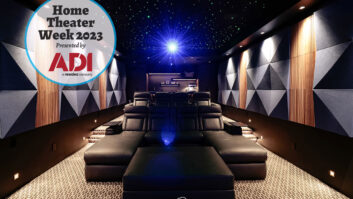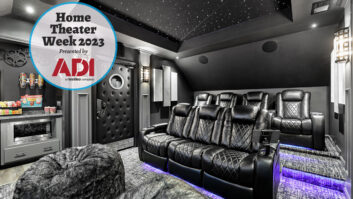
Sam Cavitt ([email protected]) is president of Paradise Theater in Kihei, Hawaii, and Carlsbad, California. When creating private theater rooms, many designers and architects now understand the need for acoustical treatments in walls and that we don’t want large windows along sidewalls. However, many popular architectural or interior treatments for ceilings can be problematic.
“We want a plain painted ceiling” is frequently the request by clients and designers that want a ceiling with no acoustical treatment and a simple, flat, smooth, painted surface. Either there is a concern about the budget or it is truly a design choice. Whatever the reason, we need to be able to support our requirement to treat the ceiling and also offer an acceptable design alternative, if we expect to overcome these objections. To support our design specification, we need to demonstrate validity. This is why it is essential to perform appropriate and accurate acoustical analysis that illustrates the difference between an untreated and treated ceiling.
Many designers and even clients may object to seams that would be visible in a stretch-fabric system. But, if budget is not as great a concern, there are acoustical plaster solutions that, when properly specified and configured, can offer excellent balanced acoustical performance while visually maintaining a level five surface. If budget is a concern, several companies offer wide-span fabrics that can deliver an acoustically correct ceiling with a seamless, architectural look.
Home Sweet Dome
A well-designed dome ceiling can add a sense of space, drama, and excitement to a room, but it also can introduce a significant acoustical distortion called focusing. The concave surface serves to reflect certain frequencies and harmonics to a specific location, causing listeners to hear a horribly altered sound at those locations. Depending on the dome shape, size, and placement, this can be a greatly or moderately destructive element. To overcome the negative effects of domes, we must perform acoustical modeling to accurately predict where the problems will occur.

Performance Theater’s engineering report shows a reverberation time for a treated theater without ceiling treatments and reverberation time for a treated theater with proper treatments. The one without treatment shows an unbalanced response in the low-mid- and mid-frequencies, while the treated ceiling brings the response into the target range (between the red lines). Next we must look at aesthetic and budgetary considerations. If a smooth-painted or even faux-painted or mural ceiling is required, then acoustical plaster products are needed. Be aware that how these surfaces are painted (for the faux and mural applications) can destroy the acoustical performance. Often a stretch fabric system can provide a more cost-effective solution. However, due to the curved characteristic, there must be seams and/or sections of some sort to allow the fabric system to conform to the curve. Remember that integrating a balanced acoustical specification in a domed application will require significant engineering, design integration support, and ongoing project support.
“We want a night-time sky”
Fiber optic “starfield” ceilings are popular in home theaters as well. These days, LED lights and other improvements have made these ceilings much simpler to integrate and capable of offering correct acoustical performance.
It is important to make sure the LED light sources are properly configured and include dimmable and controllable LED light engines to prevent improper light for video performance. The most vital consideration, however, is the acoustical characteristic of these ceiling. Many starfield products are 1-inch fiberglass panels with the fiber optics embedded. A common scenario is an entire cove ceiling treated with such a ceiling. This would represent approximately three times the amount of acoustical treatment that would be appropriate for the surface area and at a very limited bandwidth performance. The end result would be a significantly imbalanced sound field.
The good news is that the same starfield can be produced with a stretch fabric application, which allows a varied and acoustically correct acoustical treatment in the ceiling area.
We often hear the expression “no compromise” in relation to high performance. Sometimes we see these same no-compromise systems placed in compromising positions due to aesthetic elements that do not support optimum performance. By providing valid analysis and utilizing our skill and creativity to look for aesthetic solutions that will not detract from performance, we can truly say that the “sky is the limit” in simultaneously delivering high performance and aesthetics.







